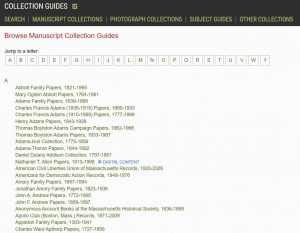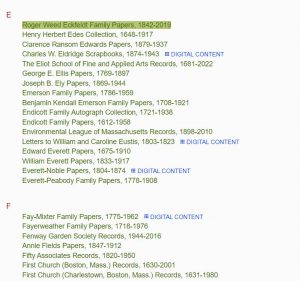By Susan Martin, Senior Processing Archivist

The job of processing the MHS’s terrific collections falls to members of the Collections Services department. Processing archivists like me are responsible for arranging and describing collections in the best and clearest way possible for our researchers, be they scholars, teachers, students, authors, genealogists, members of the general public, or MHS staff.
Not only are collections cataloged in our online catalog ABIGAIL, but many of our manuscript, photograph, graphics, and artifact collections are further described in online guides. The guides contain more detailed historical and contextual information and allow researchers to zero in on the specific material they’re looking for. But these guides are not static. They’re frequently revised, and new guides are posted on a regular basis.
I’d like to take this opportunity to highlight a few of the guides that have been added to our website recently.
The Kimball-Griswold family papers consist of papers of Unitarian clergyman John C. Kimball, his wife Emily, their adopted daughter Grace, and other family members. Rev. Kimball was a Civil War chaplain and a social activist for temperance, abolitionism, women’s suffrage, and workers’ rights. Emily Kimball was a teacher, school administrator, and women’s rights advocate. John’s brother Joseph served in the Civil War as an officer in the 37th and 116th U.S. Colored Infantry Regiments and took part in 37 battles.
The Heath-Doliber-Hedge-Hammond family papers contain papers of four interrelated families, including a large number of diaries kept by several different women. Correspondence of Charles H. Heath covers his travels to California, Jamaica, Italy, Greece, Nicaragua, and Mexico in the mid-19th century. And one interesting journal describes the “water cure” at a hydropathic institution in Brattleboro, Vermont.
And last but certainly not least, the Garrison family papers consist of papers of noted abolitionist William Lloyd Garrison and several members of his family, particularly his son George T. Garrison. George worked in various professions all over the country and during the Civil War served as an officer in the 55th Massachusetts Infantry, a Black regiment. The collection includes 50 years of his diaries. John Ritchie, whose papers also form part of the collection, was a Garrison family friend and officer of another Black regiment, the 54th Massachusetts Infantry.
These are just three of the most recent collections now available for research at the MHS. You’ll find guides to hundreds of other collections of manuscripts, photographs, and other materials at our website.
I’d be remiss if I didn’t mention here the contributions of our crack digital team that works diligently to provide digital access to MHS material. For examples of the work they do, see the recently digitized papers of the Indian Industries League, diaries of Charles Edward French and John Rowe, and 17th-century sermon notes by Robert Keayne. To see more digitized collections, look for the blue “Digital Content” label.


